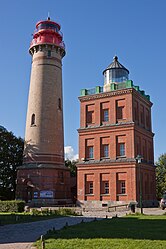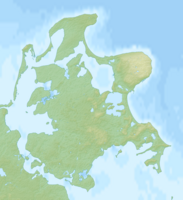Cape Arkona lighthouse
| New lighthouse Cape Arkona | ||
|---|---|---|
| New lighthouse (left) and Schinkelturm | ||
| Place: | Cape Arkona | |
| Location: | Mecklenburg-Western Pomerania , Germany | |
| Geographical location: | 54 ° 40 '46.7 " N , 13 ° 25' 57.4" E | |
| Fire carrier height : | 35 | |
| Fire height : | 75 | |
|
|
||
| Identifier : | Blz. (3) 17 sec | |
| Scope knows: | 22 nm (40.7 km ) | |
| Optics: | Headlight lens | |
| Function: | Sea fire | |
| Construction time: | 1901/02 | |
The Cape Arkona lighthouse is the name given to two sea fires on the Baltic Sea in Mecklenburg-Western Pomerania with the international serial number C 1062 . You are at Cape Arkona on the Wittow peninsula on the northern tip of the island of Rügen . The Cape Arkona bearing tower is within sight .
Both lighthouses were renovated in the early 1990s and are open to visitors. In the old lighthouse there is now the museum with an exhibition on beacons and sea rescue and a branch of the registry office. Marriages concluded here are immortalized by a small plaque in the floor in front of the tower. On each tower there is a viewing platform from which one has an unobstructed view over Rügen and in particular the Wittow peninsula. When the weather is clear you can see as far as the Danish island of Møn .
Schinkelturm
The smaller of the two lighthouses was built in brick in 1826/27 according to plans by the Prussian Oberbaudeputation . The design is mostly attributed to Karl Friedrich Schinkel , which essentially goes back to a catalog raisonné published in 1863 by Schinkel's son-in-law Alfred von Wolzüge .
Schinkel, however, was not mentioned in a printed work published in 1828 about the “Building Executions of the Prussian State”, in which the senior building officer August Adolph Günther designed the lighthouse “Design of the Königl. Ober-Bau-Deputation "called. Signatures on two drawings of the lighthouse are interpreted on the one hand as evidence of Schinkel's authorship, on the other hand as a simple administrative inspection note. From Schinkel himself, who visited the tower for the first time in 1835, no statements are known about his own involvement in the construction of the tower. On the other hand, a contemporary, the Berlin copperplate engraver Johann Friedrich Rosmäsler , named Schinkel as the author of the design in his book Prussia in Landscapes , published in 1834 . A steel engraving of the lighthouse (1835) also comes from Rosmäsler.
The foundation stone was laid on May 5, 1826. The fire was lit on December 10, 1827. The tower is 22.45 m high and has a fire height of 66 m above sea level. NN . Its beacon was visible eight nautical miles . 86 steps lead to the viewing platform at a height of 15.55 meters.
The lighting apparatus was made by master goldsmith Hossauaer from Berlin. It consisted of 17 silver-plated copper parabolic mirrors, each of which had a burner with its own oil container with rapeseed oil at its focal point. The corresponding mirrors were arranged on metal rings in two staggered rows. In 1872, six additional lamps powered by petroleum were installed. A year later, the burners were completely converted to petroleum.
The rooms of the three-story tower were used as service and storage rooms. It is also called the Schinkelturm . On April 1, 1905, he was decommissioned. It is the second oldest lighthouse on the Baltic coast after the Travemünde lighthouse .
The larger tower was built in 1901/02 right next to the old tower and put into operation on April 1, 1905. It is 35 m high and has a fire height of 75 m above sea level. NN . It is made of bricks and stands on an octagonal granite base.
New tower
On June 27, 1894, the plans for an electrically powered beacon to replace the old tower were made by the company Helios Aktiengesellschaft. This company built and assembled the lighting apparatus in 1902. This consisted of two carbon arc lamps mounted on a turntable . Each was surrounded on three sides by headlight lenses , in the fourth direction a shutter darkened the light. This lighting device existed until 1921, when two incandescent lamps were installed as light sources. In 1995 this system was exchanged for a metal halide lamp with an operating light intensity of 2.325 million candela . Your electric lightning bolt emits three lightning bolts every 17.1 seconds and is visible for 24 nautical miles. At the same time, one of the two triple lenses was dismantled and exhibited to the public. The tower has a total height of about 35 meters and a fire height of 75 meters. 175 steps lead to a viewing platform that is open to the public at a height of around 28 meters.
literature
- Horst Auerbach: The lighthouses at Cape Arkona . Kai Homilius Verlag, Berlin 2002, ISBN 3-931121-43-7 .
- Horst Auerbach, Hans-Joachim Luttermann: Cape Arkona and its lighthouses . Busse + Seewald, 1998, ISBN 3-884-12249-5 .
Individual evidence
- ^ Rita Gralow: Doubts about authorship. (No longer available online.) In: Heimatkurier Mecklenburg-Vorpommern. Nordkurier, March 1, 2010, archived from the original on August 9, 2010 ; Retrieved on March 22, 2010 (according to Reinhart route: Schinkel and the lighthouse on Cape Arcona. Yearbook Prussian Cultural Heritage 32, Berlin 1995). Info: The archive link was inserted automatically and has not yet been checked. Please check the original and archive link according to the instructions and then remove this notice.
- ↑ Helmut Hannes: The Swinemünde lighthouse - a Schinkel building? In: Pomerania. Journal of Culture and History. Issue 2/2011, ISSN 0032-4167 , pp. 2-7. (there is also a picture of the steel engraving)
Web links
- Literature about lighthouse Cape Arkona in the state bibliography MV
- Lighthouses at Cape Arkona at the Stralsund Waterways and Shipping Office
- Website of the Cape Arkona Tourist Association with information about the towers on Cape Arkona
- All-round view from the viewing platform of the New Lighthouse


